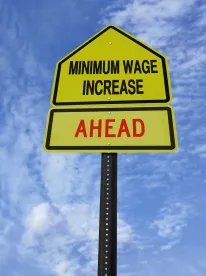Humor me for a second. Imagine you are an employee earning either an annual salary or an hourly wage. You are in the middle of your year-end review with your supervisor. You sit down and discuss fun things like strengths, weaknesses, travel destinations and perhaps (but hopefully not) the company holiday party. Then it comes time to discuss your potential salary increase, not only for next year, but for the next five years of your employment. Your supervisors propose to increase your salary approximately 24% this year and provide an annual increase somewhere between 11% to 17% for the next five years thereafter in order to provide you with a total wage increase of approximately 110% of your current annual salary.
Impossible, right?
Not impossible for the approximately 3 million American workers who earned hourly wages at or below[1] the federal minimum wage last year. Last week, presidential candidate and Senator Bernie Sanders of Vermont announced a bill to pass the Pay Workers a Living Wage Act. The bill, which is co-sponsored by Senator Edward Markey of Massachusetts, proposes to gradually increase the current federal minimum wage of $7.25 over the course of the next five years until the minimum wage settles in at $15.00 per hour in 2020. The first annual increase will come in 2016, raising the minimum wage to $9.00 per hour. Thereafter, the minimum wage will be increased each year until 2020 by an additional $1.50 per hour. A similar bill was also recently referred to the U.S. House of Representatives’ Committee on Education and the Workforce by Representatives Raul Grijalva of Arizona and Keith Ellison of Minnesota.
According to a release from the Sanders camp, the current federal minimum wage is “a starvation wage.” A fact sheet in support of the bill provided by Senators Sanders and Ellison cites that around 54 million U.S. workers currently make less than $15 per hour, and almost half of these workers are age 35 or older. The fact sheet opines “[n]o one working full time should be in poverty. It is time to pay workers a living wage of at least $15 an hour.”
By my calculation, there has never been an increase of this significance over a five-year period since the federal minimum wage was first passed in 1938. The highest percentage adjustment to the federal minimum wage appears to have been from 1949 to 1950 when the minimum wage increased approximately 88% from $.40 to $.75 per hour. The next highest increase in terms of percentage appears to have been a nearly 66% increase from the 1973 minimum wage of $1.60 per hour to $2.65 in 1978. The majority of other increases over five-year periods appear to be less than 33%. The fact sheet supports the need for the dramatic proposed increase in such a short time by explaining, “[i]f the minimum wage had been raised since 1968 at the same rate as inflation and productivity – i.e., the rate at which the average worker produces income for the employer – it would be more than $26 per hour.”
An astounding 47% of those earning the federal minimum wage purportedly are working in the fast food industry. The fact sheet cites a study conducted by the University of Massachusets-Amherst that “concluded an increase to a $15 minimum wage could be fully absorbed by [fast food industry] employers without resorting to cuts in employment levels, lowering the average profit rate, or reallocating funds from other areas of operation.” To reach this conclusion, the study assumes that the increase in labor costs will necessarily “increase workers’ commitment to their job” thereby resulting in lower turnover rates and savings “on the costs of recruiting and training new employees…” The study also acknowledges that one way for employers to “cover a share of their increased [labor] costs [is] by raising prices.” However, the elephant in the room only summarily addressed by the study is to what extent the cost of higher wages simply will be reallocated directly to the consumer. No specific answer is provided – by the fact sheet or the study – regarding the extent of potential price increases. Therefore, Joe and Debbie Consumer who enjoy their fast-food burritos, burgers, and footlongs can almost certainly expect to share a portion of the increased labor bill that could come with the passage of the Pay Workers a Living Wage Act. The precise amount of the cost on the other hand remains to be determined.
The national movement behind increasing minimum wages comes after several cities such as San Francisco, Los Angeles, and Seattle already started down a path toward a $15.00 per hour minimum wage. Last week, the New York Wage Board appointed by Governor Andrew Cuomo announced it would finalize its recommendation to the state’s labor commissioner to pass legislation moving the minimum wage up to $15.00 as well. Another Governor in the minimum wage debate spotlight is Governor Jerry Brown of California, who signed into law minimum wage increases in California that will result in a $10.00 per hour California minimum wage by January 1, 2016. However, after two of California’s leading cities (Los Angeles and San Francisco) implemented a plan to increase minimum wage as above, public pressure remains on Governor Brown to implement a further state-wide increase to the apparently magic $15.00 per hour number.
[1] Limited exceptions to the Fair Labor Standards Act’s minimum wage provisions permit certain employers in specific industries to pay workers less than the federal minimum wage.



 />i
/>i

